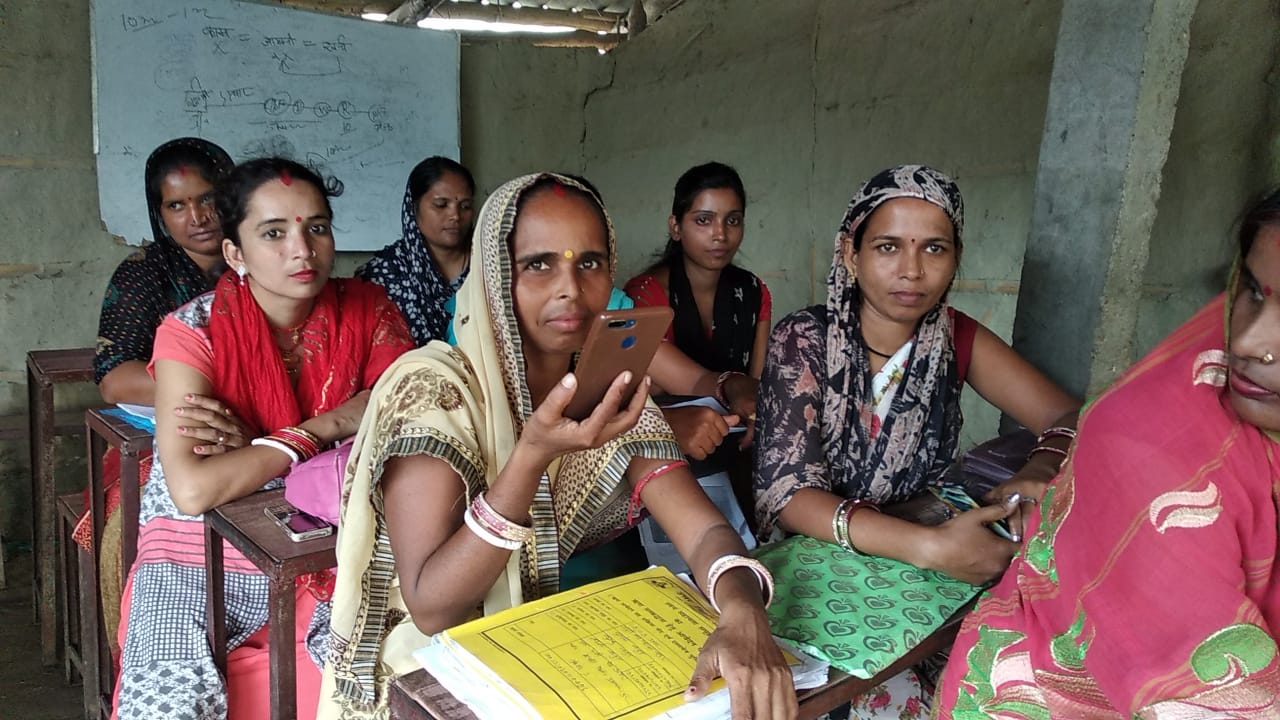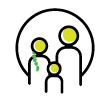In Bihar’s Nalanda district, women utilized IVR and a mobile application to power a voice-based community media platform Meri Awaz Meri Pehchan (“My Voice My Identity”) that fostered peer learning and collective action among users. Women created and shared information and views on topics such as early marriage, dowry, and water availability, and used the platform to safely express their concerns and discuss collective solutions to their most pressing challenges.
The project received seed funding in November 2018 from USAID as part of the Women Connect Challenge, a “global call for solutions to improve women’s participation in everyday life by meaningfully changing the ways women access and use technology”. The solution was among the nine winners globally in its first round.
Why this project: Access to media and information is highly unequal across India along the lines of gender, rural/urban locations, caste, class, disability, and other forms of marginalisation. This is especially the case among women in rural Bihar, where patriarchal norms limit their mobility and access to technology such as mobile phones. Poor coverage of women in mainstream media further reinforces a male perspective, compounding the marginalization of women’s perspectives. There is also a lack of broader platforms where women can safely voice their concerns, learn from peers and grow their capabilities, leading to restricted self-expression. Meri Awaz Meri Pehchan (MAMP) sought to do the following towards the broader goal of gender equality:
- accelerate the access of women to technology
- enable discussions around social and cultural practices and perceptions to shift social norms,
- strengthen local governance
MAMP worked towards these objectives by:
- fostering peer learning and collective action among women users
- providing actionable information to guide progressive practices and claims to entitlement
- acting as a source of evidence and pressure on local government to increase the chances of accountability and complaints redressal
Our community and their needs: MAMP primarily involved women and girls aged 18-45, with access to (even if not ownership of) mobile phones, and have mobility to go outside their homes to participate in activities such as the village meetings (Gram Sabhas). The women and girls belonged to both historically privileged and historically marginalised castes, including Dalit castes.
The project began with a needs assessment to understand the perspectives of women and girls, as well as their male family members’, on women’s social, economic and political empowerment. A series of Focus Group Discussions (FGDs) with women aged 21 to 40, and women and girls less than 21 years old, to understand key content areas and specific messaging. Based on the needs assessment, we identified key content areas as education (for young women themselves and for their children), livelihood, agriculture, information on government schemes, financial literacy, discouraging early marriage and giving dowry, women’s political participation, violence against women, and women’s health. The needs assessment also helped us understand that messaging for women from Mahadalit communities had to be tailored in some instances.
Everyone knows that giving or accepting dowry is a crime, but it is still prevalent and it is impossible to marry of daughters without giving dowry. Even neighbours and relatives would laugh if we tried to marry off our daughters without paying dowry.
– a participant of our needs assessment from Haranut, Bihar
Creating the right technology mix: The needs assessment also helped us understand the specific technological requirements for this project. Only around 1 in 4 of our FGD participants had finished high school, and only 40% had their own mobile phones – and there was strong resistance to “allowing” young women to own and use phones as it is generally seen as inappropriate for young women to be talking to others. Our earlier work with women has also shown that they usually do not see their “need” to use a phone for anything beyond talking to a relative, something that their male family members can help them do.
These factors meant that our community engagement measures had to include more women being positioned as community leaders, who could encourage other women to use their phones, and in the case of those attending SHG meetings, to bring their phones to the meetings. We also helped them save the platform’s number or gave stickers with the number so that women did not need to remember it and could easily access it.
The IVR was created to be simple for users to listen to, play for others, share their thoughts on what they hear, and send content to other people. Complexities were introduced slowly, once the audiences were comfortable with basic navigation of the IVR.
Simultaneously, we developed and rolled out a distributed moderation interface to be utilised by the community reporters. The content received on the platform from the community goes through the process of moderation, which helps decide which content stays for how long to be listened to and commented on by the users, where it appears in the order of content users listen when they access the platform, and whether the same content is suitable to be played on the platform, or it needs some modification (and therefore re-recording), etc.
The distributed moderation interface was developed specifically to encourage decentralisation of this process of vetting the content that was to be made available on the platform. This way, the content that eventually goes up on the platform – for instance, opinions shared by listeners – were moderated, in consultation with the community by volunteers and reporters, where the community have more stakes in deciding which are the contents that are more relevant to them.
Creating engaging, relevant – and “safe” content: Keeping in mind the profile of our users and insights from our needs assessment, we knew that the platform had to be made directly appealing to the women – obviously different from our other platforms that are made for mixed gender groups. For instance, our content was made more entertainment-oriented, such as through song competitions, dramas with local and contextual characters and incidents, highlighting women’s social and legal entitlements such as on property ownership, details of women’s helplines, content on maternal health and nutrition, and highlighting achievements by women in local and national platforms. Our objective was to create a safe space for women to engage and participate in all these thematic topics.
At the same time, we had to treat these topics in a non-threatening way, so that even if men were to listen to the content there is less chance of backlash or stopping women from listening to “wrong” things. The content had to be created in a way that women could listen to it along with their family and thereby be “allowed” to use this service in the future without being questioned. We had to build this trust through our content and engagement activities.
How we enabled community participation: With a broad content strategy and technology in place, we identified a cadre of women, from diverse communities and age ranges, to be community reporters and volunteers. These women were trained on thematic and technical aspects (i.e. using our IVR technology), on thematic content creation – including those based on community demand and requirements – as well as to mobilise users by encouraging women to listen to the platform.
Our research showed four major pathways to engage community members and enable their participation: by reaching out to educational institutions, to engage girls aged 12-20; Self-Help Group meetings, to reach women aged 21-45; community meetings and village health centres to reach a broader spectrum of women. For those who are hardest to reach – the very poor, and marginalised due to caste – our community volunteers go to the remote villages to reach users and to help spread important development information.
Some of the most popular content on MAMP is that on government programs that primarily affect those with grievances or disabilities, widows, and other marginalized people from the lowest castes. In many cases, women work together to advocate for change and to let their voices be heard by local decision makers; in one community, the mayor has used the platform to directly connect with women and solicit their feedback on community development strategies.
Outcomes: MAMP has reached 17,000 women since February 2019, when the IVR was rolled out. We have published over 6,000 voices from the ground, of women’s thoughts, experiences, and even songs on issues that are close to their heart.
Meri Awaz Meri Pehchan users have reported using the platform to help convince their husbands to continue education for their daughters, delay early arranged marriages until girls have obtained some level of education, gain access to beneficial government programs, and to improve their lives in other ways. Listen to the voices of women who have been encouraged to take small but firm steps towards economic, social and political empowerment:
One day a didi (sister) came to our village and gave us a pamphlet and explained about MAMP and how by listening to it we can know about and contribute on many socially relevant programmes and issues. I started listening to MAMP and one day I heard about Kanya Samrudhdhi Yojana. But I couldn’t gather all the information from the clip. So, I approached the same didi and with her help I gathered the relevant information about the yojana and registered my daughter for it in the Anganwadi Centre. After 15 days, I received 2,000 rupees as the first instalment of the yojana
– Shilpi Kumari, May 2019
My life has changed because of Mobile Vaani. Since the early days of my marriage, I was emotionally abused by my in-laws. I never felt like raising a voice against that and accepted it as my lot in life. The programmes on MAMP showed me a new way. I shared my pain with one of the Mobile Vaani didis and she suggested that I voice my concerns to my husband. The didi and I also spoke to my in-laws about why their behaviour was improper. A lot has changed since then. My in-laws have started behaving well with me. Meri Awaz Meri Pehchan helped me to resolve this crisis in my life
– Anjana Kumari, April 2019
Projects such as MAMP, grounded as they are in the community and involving community members as volunteers, also lead to significant changes in the lives of the volunteers. Watch this video to see how our community reporters and volunteers were able to make positive changes in their own lives while working on MAMP, and inspire other women to do the same: https://www.youtube.com/watch?v=M5KdSq1_EQY&t=44s





